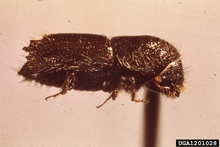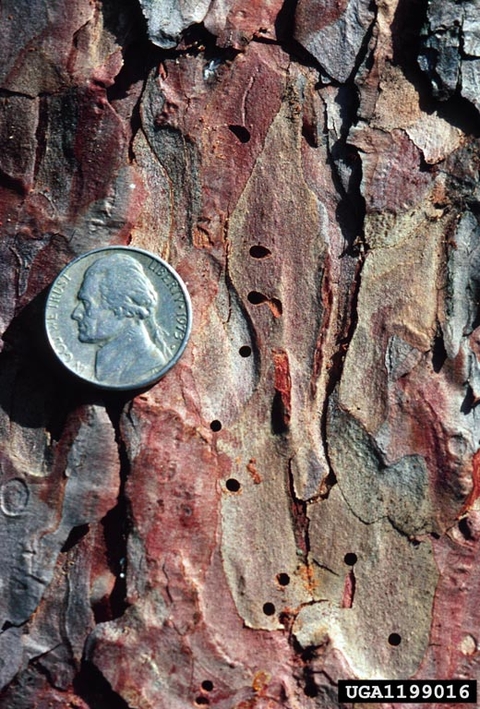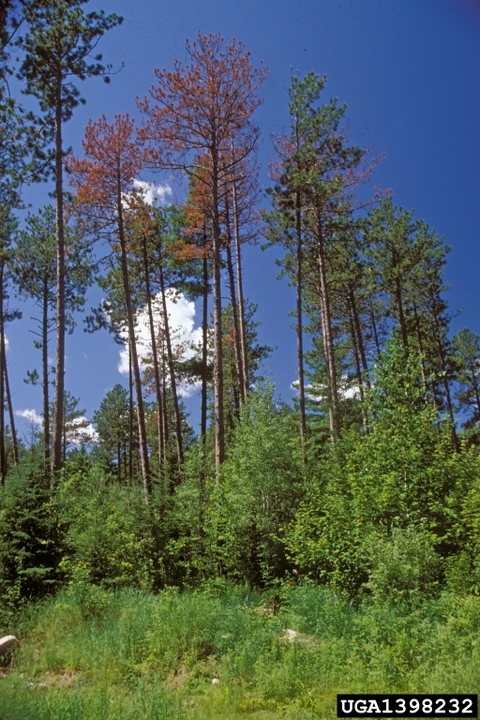Quick facts
- Bark beetles are associated with pole-sized and mature red pine forests.
- Outbreaks are commonly observed during drought years.
- Thinning is one tool that reduces competition and lowers the likelihood of bark beetle outbreaks.
- Time thinning and other forestry operations to occur during the fall and winter months when bark beetles are not active.
- Thinning should not occur during a drought and for one year following a drought.
-
Operators should avoid wounding trees during thinning and harvesting operations.
-
Consult a forestry professional to determine the appropriate time of year to conduct thinning operations to minimize bark beetle damage.
Pine bark beetles (including the pine engraver species Ips pini and Ips grandicollis) are responsible for killing many pine trees in Minnesota.
Minnesota’s red pines are a commercially and ecologically important species throughout the state. Pine engraver beetles are commonly associated with pole-sized (21 to 50 years) and mature red pine forests (older than 50 years).
According to Minnesota Department of Natural Resources annual reports, bark beetles impacted 4,891 and 3,150 acres of pine forests in the state in 2014 and 2015, respectively. Actual acreage is difficult to determine since bark beetle activity occurs in variable-sized pockets. Outbreaks are commonly observed during drought years.
Beetles develop tunnels beneath the bark, which reduces the flow of water in the tree, ultimately contributing to death in an unhealthy tree.
Notable bark beetle outbreaks associated with drought years in Minnesota
| Drought year(s) | Notes from MNDNR forest health reports |
|---|---|
| 1976-1977 | On sandy soils, conifers of all ages died or were weakened to the point where bark beetles became a problem. |
| 1987-1988 | A large number of bark beetle pockets were initiated in 1987. Four generations of bark beetles were bred in 1988. Eighty percent of all pine plantations in Stearns, Benton, Sherburne, Kanabec, and Anoka counties had active bark beetle pockets in 1988. Weather conditions identified this as a 150-year drought. |
| 2004-2005 | In southeastern counties, a significant amount of bark beetle activity was observed in the early summer of 2004. |
| 2006-2009 | This serious and prolonged drought created stress conditions favorable for bark beetle build-up. Damage from Ips and Dendroctonus bark beetles totaled 3,600 acres in 2009. |
| 2012 | Damage from Ips bark beetles totaled 310 acres, but adequate rainfall occurred in the central portion of the state to minimize activity. |
Life cycle
- Bark beetles overwinter in the duff layer beneath trees, emerging as adults in April-May.
- After boring into bark, adults form galleries beneath the inner bark to lay eggs.
- Eggs will eventually become adults over the span of several weeks and will bore outside of the bark, forming small BB-sized exit holes.
- When numerous, this resembles damage from a “shotgun blast”.
- A first generation of adults emerge in June, and a second in August.
- Depending on conditions, a third generation can develop within the same year.
Tree symptoms and vulnerability
- Bark beetles attack standing pines, freshly-cut pine logs, and slash left on the forest floor.
- On standing pines, needle color often turns yellow and appears reddish-brown by the late summer.
- Outbreaks often occur in small pockets of 3 to 5 trees.
- The stem and branches can be inspected for beetles:
- Look at sawdust-like material near holes.
- Remove bark over the holes to check for beetle larvae and galleries.
Red pines are particularly vulnerable to bark beetles that attack weakened trees during drought years.
Pines can overcome bark beetle attack by producing pitch, but pitch cannot be produced in sufficient quantities when stressed under drought.
Trees showing damage from bark beetles are also often subject to additional stressors such as Armillaria root rot.
Other wood borers
Wood borer larvae are 1-inch or more in length, while bark beetle larvae are 3/16th-inches long. Wood borers are not a threat to living pines.
Mountain pine beetle (Dendroctonus ponderosae) is a western bark beetle species but has not been found in Minnesota’s forest as of 2018. States with mountain pine beetle are prohibited from bringing their pine wood with bark into Minnesota.
Disease lookalikes
Diplodia is a widespread disease across Minnesota that causes shoot blight. Needles will turn straw colored on pines which may mimic symptoms of bark beetle damage. Tiny, black spores found at the base of dead needles, on cone scales, or on twigs and branch bark can confirm Diplodia.
Red pine is managed for various goals and objectives across Minnesota ranging from timber production to wildlife habitat. This creates a wide variation in forest structure and composition, with some forests receiving several forest management treatments and others more natural.
Red pine forests producing high quality saw logs are generally managed in even-aged plantations.
In general, forest management that emphasizes long-term strategies that sustain tree vigor can prevent or minimize the risk of beetle outbreaks.
Thinning
Thinning is one tool that reduces competition and lowers the likelihood of bark beetle outbreaks.
Red pine responds robustly to various thinning regimes and intensities. The type and intensity of thinning will depend on the site and stand conditions. The Revised Managers Handbook for Red Pine in the North Central Region, published by the USDA Forest Service in 2006, provides a number of management recommendations for site conditions
Proactive treatments are the best strategy for increasing resistance to bark beetles. Consider timing thinning and other forestry operations to occur during the fall and winter months when bark beetles are not active.
Thinning should not occur during a drought and for one year following a drought. Drought conditions may also hinder successful tree regeneration following forest management treatments.
- If thinning or cutting occurs in the winter or early spring, logs and slash should be removed before June 1.
- If thinning or cutting occurs in the summer, logs and slash should be removed within three weeks of when the thinning or cutting occurred.
- Woody debris greater than 3 inches in diameter should be removed or destroyed.
- Operators should avoid wounding trees during thinning and harvesting operations.
The MN DNR updated these guidelines in 2015 by allowing timber sale administrators to allow or stop harvesting operations on state lands to minimize damage from beetle infestations.
MN DNR guidelines to minimize bark beetle damage during pine thinning
| Time of year | Notes from MN DNR forest health reports |
|---|---|
| December 1 through May 31 | Haul or destroy cut pine greater than 3 inches in diameter by June 1. |
| June 1 through August 31 | Haul or destroy cut pine greater than 3 inches in diameter within 3 weeks. |
| September 1 through November 31 | No special restrictions for pine cut in this period. |
Yard trees
- If freshly cut conifer firewood or woody debris from conifer species is lying near healthy pines, move the wood away from the trees.
- Debris can be moved to an approved wood waste disposal site or chipped.
- Water trees during times with low rainfall and continue to monitor their health.
Gilmore, D.W., B.J. Palik. 2006. A revised managers handbook for red pine in the North Central Region. GTR NC-264. St. Paul, MN: USDA Forest Service, North Central Research Station. 55 pp.
Minnesota Department of Natural Resources. Pine bark beetles (Ips species).
Red pine management guide: a handbook to red pine management in the North Central region.
Photo credits: Wayne Brewer and Steve Katovich
This publication was reviewed by Steve Katovitch (US Forest Service) and Marcella Windmuller-Campione (UMN Dept. of Forest Resources).
Reviewed in 2018




